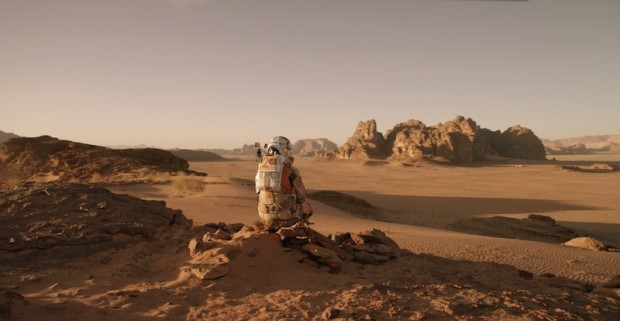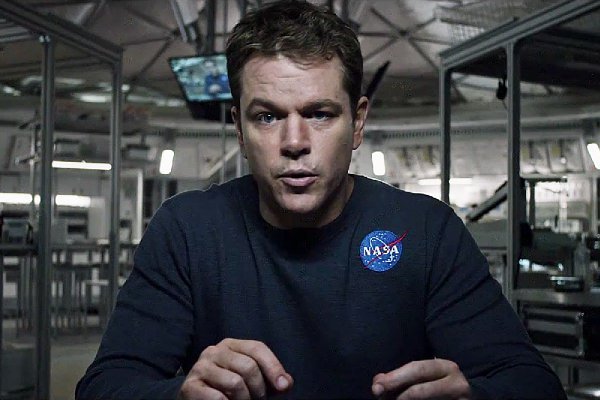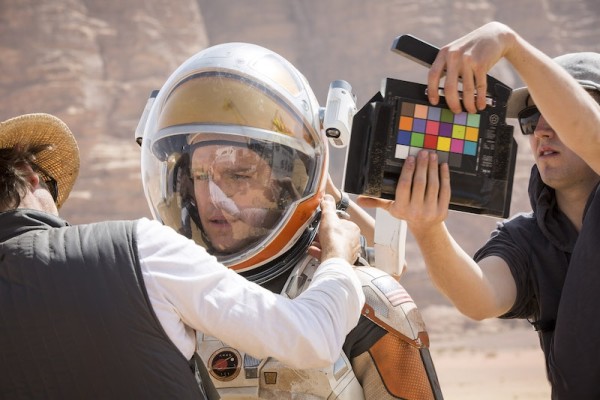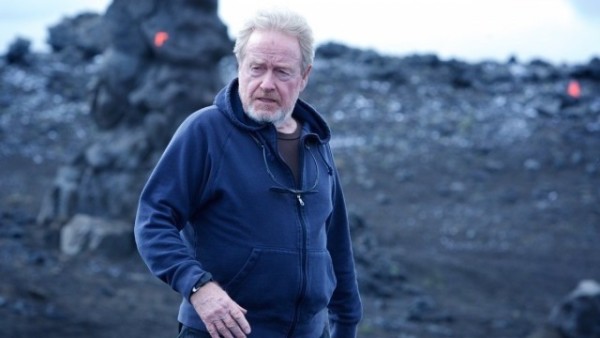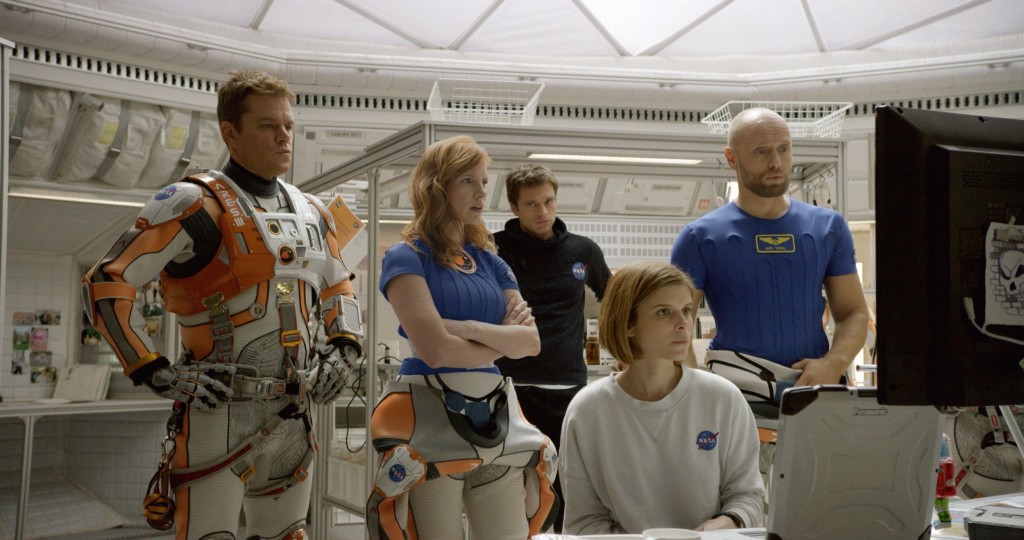Is The Martian the best movie of the year?
Genre: Sci-fi
Premise: When an astronaut is mistakenly left on Mars, he will have to draw upon all of his survival skills to stay alive until NASA can rescue him.
About: The Martian was a huge self-published e-book success, which led to a major book publisher buying and repackaging the novel (selling it for a lot more money, of course), which led to 20th Century Fox buying the film rights, which led to Ridley Scott and Matt Damon coming onto the project, which led to production this past year, which led to it coming out this weekend, which led to a 100 million dollar worldwide weekend. Cabin in the Woods writer Drew Goddard adapted the novel from Andy Weir.
Writer: Drew Goddard (based on the novel by Andy Weir)
Details: 2 and-a-half hours
The Martian is an awesome film. It may even beat out Fury Road as my favorite film of the year (way to keep the suspense going from that header, huh?). That’s because while Fury Road was pulse-poundingly awesome, The Martian actually made me feel something. This is the kind of film that reaches inside of you, twists your insides around, before wrapping you in a big warm motherly hug.
It’s also a movie every screenwriter should watch as it plays with the format enough to challenge it, yet always stays respectful of the storytelling techniques that make movies work. This is the first project I’ve ever reviewed as a book, then a script, then a movie, so I’ve seen it go through all of its incarnations. Watching that metamorphosis happen has allowed me to observe the specific choices the filmmakers made that turned this into one of the best movies of the year.
For those who don’t know anything about The Martian, it follows a botanist-astronaut named Mark (as in one letter removed from “Mars”) Watney, who’s been left up on Mars after he was presumed dead during a violent storm. Mark realizes he has 300 days worth of food, and the next Mars mission is 1400 days away. Mark will have to turn to science to bridge that gap.
At a certain point, NASA realizes that Mark is still alive, makes contact with him, and over the course of the next couple of years, the two sides plan a rescue. Of course, everything that can go wrong does go wrong, and the final rescue is fraught with so many hiccups that it is literally a 1 in a million shot. Will they bring Mark home? Or will Mark become the first ever human being taking up permanent residence on the big red planet?
So if you remember, the thing that always worried me about this project was time. Mark Watney is stuck on Mars. And we’re told it will take four years to save him. For those of you who read the site regularly, you know the final essential ingredient for my screenplay formula (GSU) stands for “urgency” (the first two stand for “goal” and “stakes”). If your hero’s problem doesn’t feel like it needs to be solved RIGHT NOW, there’s a good chance the story will move to slowly for the audience and they’ll get bored.
I’m not the first one to say this. Practically every professional screenwriter will tell you the same thing. However, despite forever-away four year ticking clock, The Martian never once felt slow. So the question becomes, how the hell did they pull that off?
This is the first time in a long time that I’ve felt like I learned something BIG from a movie. The Martian taught me that if you don’t have an urgent timeline, you can create urgency in the moment. That in-the-moment urgency will then distract the audience from the big goal being so far away.
For example, Mark Watney learns that he’s stuck on Mars for four years. However, Mark has a very pressing issue RIGHT NOT. He’s got to learn how to grow food or else he dies. What follows, then, is a sequence (a mini-movie basically) where Mark figures out how to grow food.
We are so riveted by this objective that we’re not thinking about the four years. We’re thinking about right now. We’re thinking, is Mark going to learn how to grow food RIGHT NOW? In a way, it’s a distraction technique. Distract the audience by entertaining them in the moment.
We see this approach being used throughout the movie. When Mark’s finished with the food, he must learn how to create water to grow the food. He then must figure out how to communicate with Earth. When he’s done with that, he has to figure out how to get a truck, that was only meant to drive 20 miles, to drive 1000.
For you advanced screenwriters, you’ll see that sometimes Goddard switches the current story goal over to NASA. When you’re a beginner, you focus on keeping your main character goal-oriented, but when you get some experience, you realize that as long as SOMEONE in the script has an immediate goal that matters, the story will continue moving.
So for example, at a certain point, NASA must figure out how to send a re-supply ship to Mark. That’s their goal. And for a 12 minute sequence, that’s what drives the story.
Another thing The Martian does that I’m constantly telling you guys not to do, is it offers a complex story. What do I always say? Simple story, complex characters. Not the other way around.
Here we have a super long timeline. We have TONS of characters. We’re jumping around a lot. It’s far from the simplicity of a movie like Taken or Die Hard. So why does it still work? Because The Martian’s storyline is so clear. Let me repeat that. A complex story only works if the engine behind the story is EXTREMELY clear.
We are NEVER confused about what’s happening here. Mark Watney needs to be rescued. That’s it. It’s a very clear setup. In addition to this, Drew Goddard does a great job CHECKING IN on us. “Checking in” is the process by which you remind the audience what it is the characters are doing and why. If your story is even remotely complex, you will rely on checking in.
Contrast this with a similar movie that DIDN’T check in enough. Interstellar. There were times in that movie where we weren’t sure what it was Matthew McConaughey’s character was doing. He was visiting 8 planets or something? Looking for a solution to earth’s food problem? All while Michael Caine was create a gravity-machine to lift the earth’s population into space. What??
If, in The Martian, NASA needed to build and send a supply ship to Mark, there was a scene where the characters clearly discussed this. They told us why they were doing it and what the repercussions were if they failed. The combination of a VERY CLEAR OVERALL GOAL and constant CHECKING IN made this seemingly complex story easy to follow. That’s strong writing.
The script also offers some advanced screenwriting techniques, one of them being WEAVING (in the past I’ve referred to this as “interweaving.”). Okay, this might be hard to follow so pay attention. When you write a movie that has a series of goals one after another, like this one, you run the risk of the script becoming too compartmentalized.
You end up breaking things into very obvious sequences that occur in an overly-ordered sequential fashion.
1) Mark Watney must figure out how to grow food.
2) Mark Watney must figure out how to make water.
3) Mark Watney must figure out how to communicate with Earth.
4) Mark Watney’s bay just blew up. He must put it back together.
While there’s nothing wrong with this, especially if the story is compelling, good writers weave these compartments into one another so that the story feels more organic.
For example, two of the goals Watney must achieve are a) figure out how to communicate with earth and b) figure out how to drive his truck 1000 miles to the rescue destination.
If you’re thinking about these story beats in a linear fashion, the placement of each sequence is obvious. You first write the sequence where Mark goes to find the old Mars rover so he can communicate with earth, and then, later in the story, when it’s time for Mark to get his truck to the rescue point, you write the sequence where Mark figures out how to make a limited 20-mile truck drive 1000 miles.
And it would be fine if you did it this way. But what WEAVING does is it takes a part of a future sequence, and sets it earlier in the story, so as to break up the monotony of this “And then this happens, and then this happens, and then this happens” ordering.
So Watney actually starts testing his 1000 mile truck drive BEFORE he deals with the communication problem, despite the communication problem being the immediate problem he has to deal with. It’s this displacement of events that keep a story from feeling too structured. And with screenwriting being such a structure-heavy form of storytelling, this is an invaluable tool to have in your arsenal.
Moving on, one of the hardest things to do in an adaptation is decide what stays and what goes. Goddard did an amazing job here. He knew exactly the story beats to include and got rid of all the fat. There was one part he got rid of, however, that surprised me. When I first reviewed The Martian in book form, one of the big story beats was the final drive to the rescue point, which included a HUGE STORM Watney had to drive into.
It was the perfect final obstacle to Mark Watney’s incredible journey. He was so close after all this time, yet now this storm threatened everything. At the time, I noted they should consider building the story around this storm. Start with Mark Watney driving through the storm, then tell the story in flashback form, so you had to include the exciting parts of his Mars stay.
In the final film, however, there is no storm. It was eliminated from the story.
And you know what? They were 100% right to get rid of it. While the storm did provide a huge obstacle, Goddard and Scott realized that we had just spent 2 hours watching Watney battle every obstacle imaginable. The audience was ready for the climax. One more big obstacle would’ve felt like one too many.
And that was a big lesson to me. I love throwing obstacles at characters. It’s the lifeblood of storytelling. But there comes a time when it’s too much – when you need to dress your hero up in that gown and get them to the ball. Mark Watney was ready to dance.
The final masterful stroke of this film was one of the most age-old storytelling techniques there is. MAKE THE SITUATION IMPOSSIBLE. The Martian is all about Mark Watney surviving the impossible, over and over again, much like they did with Gravity. But they went a step further. They made sure the CLIMAX was THE MOST IMPOSSIBLE SITUATION OF ALL.
[spoilers below]
And that’s a lesson I want you to take away from this. Make the situation impossible. But make the ending ESPECIALLY IMPOSSIBLE. Mark Watney has to blast into space in a capsule that has a TARP for its top. The ship rescuing him is only going to have one shot to catch him and it’s going WAY TOO FAST to do so. The attempted meeting point is way off. At one point, Mark must puncture his own suit to use as a jet to guide him to the ship. I mean WTF!!!!
The reason the end of The Martian is so impactful is because they make it seem like there’s no chance for success. The odds are just too far out of Mark’s favor. So when they actually succeed, we’re so shocked, we’re overcome with emotion.
Not enough writers challenge their heroes during a screenplay. They’re afraid to put them in the worst situation possible because, frankly, they’re not sure how to get them out of it. But part of your job as a screenwriter is to say, “how can I make this as bad as possible for my hero” and then, after you’ve put them in that terrible situation, rely on your intelligence and imagination to get them out of it.
But if you never put them in the bad place to begin with, chances are your story’s going to lack drama.
The Martian is a masterful movie on every level. There are so few cracks in its armor that it’s borderline perfect. It’s Cast Away for a new generation. If you haven’t seen this movie, drop what you’re doing right now and do so!
[ ] what the hell did I just read?
[ ] wasn’t for me
[ ] worth the read
[xx] impressive
[ ] genius
What I learned: Create urgency WITHIN the moment. If the timeline of your screenplay is long, like The Martian, look to create a series of sequences that contain urgency. If your reader is focused on the urgency of the moment, they’ll forget about the lack of urgency in the long run.

